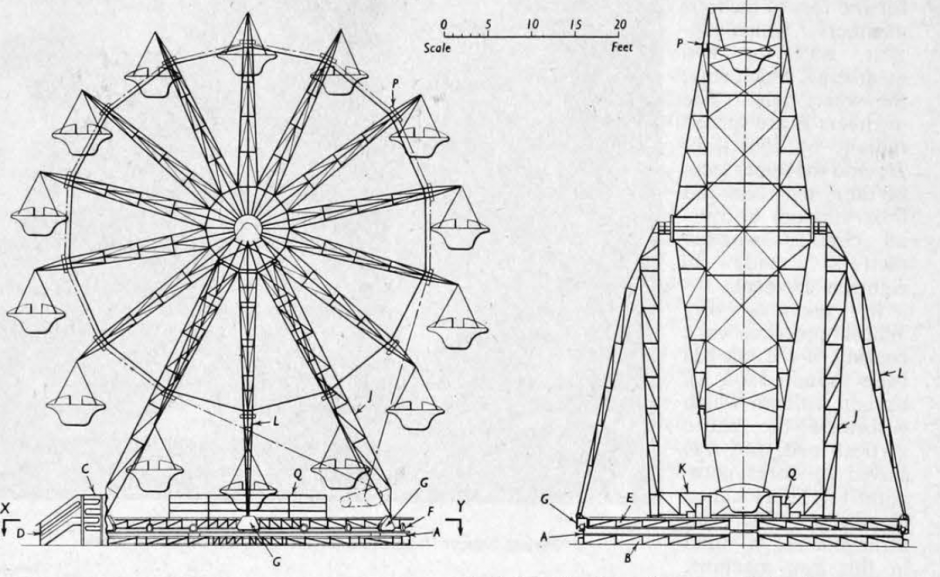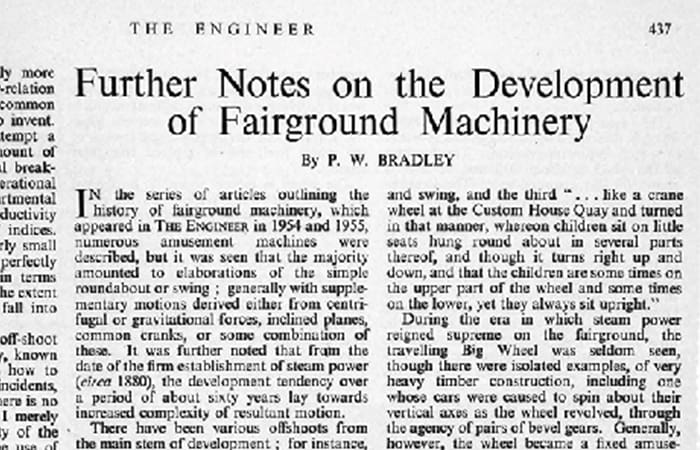The Engineer readers on a ride when the UK was introduced to what funfair enthusiast PW Bradley called 'a new big wheel era for fairgrounds'

Battersea Park's "Flying Saucer" fairground machine
The world’s tallest big wheel can be found in Las Vegas where the High Roller stands at a height of 168m and has been entertaining the public since March 2014.
This achievement would no doubt have enthralled PW Bradley, a funfair enthusiast who contributed ‘Further notes on the development of fairground machinery’ in the 22 March 1957 edition of The Engineer.
READ THE ORIGINAL ARTICLE HERE
Bradley had already contributed to this journal on fairground matters and reappeared to focus on big wheels, the development of which goes back as far as 1620, a fact brought to readers’ attention by way of historical waypoint and technological baseline.
Alerting readers to Volume 1 of The Travels of Peter Mundy in Europe and Asia, Bradley recalled a journey that took Mundy to a fair in Philippopolis, southern Bulgaria, where three kinds of amusement were observed: two being crude versions of the roundabout and swing, and the third “like a crane wheel at the Custom House Quay and turned in that manner, whereon children sit on little seats hung round about in several parts thereof, and though it turns right up and down, and that the children are sometimes on the upper part of the wheel and sometimes on the lower, yet they always sit upright”.

For Bradley, the big wheel was a roundabout with a horizontal axis that would gradually become a fixed feature in amusement parks.
“In the middle ’thirties, smaller wheels of American design, with up to sixteen two-seater cars and of all-metal construction, began to appear in our coastal amusement parks. Later, in the immediate post-war period, the smaller of these (the twelve-car version) became popular as a travelling proposition… several operators have eased the moving operation by semi-permanently building the base frame and the lower parts of the standards on a heavy road wagon.”
This portability was an important development and, in August 1956, the UK was introduced to what Bradley called “a new Big Wheel era for fairgrounds”. He reported that the ride was brought from France and erected for the last few weeks of the Battersea Park fun fair season. It consisted of a big wheel mounted on a large roller-bearing turntable and Bradley noted that “the resultant of the two continuous rotations is quite unlike the motion of any known previous amusement machine in being spherical”.
“The device therefore represents a definite advance in fairground engineering design,” wrote Bradley. “In accordance with modern practice, welded tubular construction is extensively employed, and other components are of pressed steel. Timber is utilised only in the circular loading platform and steps. The example seen in Battersea Park has fourteen cars, each seating four persons. The diameter of the wheel is about 50ft and its axis is about 36ft above ground level. The diameter of the base turntable also is about 36ft.”
Bradley further observed that in previous big wheel practice, each bearing of the axle had been mounted on an upright column which withstood the entire vertical load, and was stayed by three comparatively light inclined members, which are constituent pieces of a complex structure, especially in load-bearing structures.
“Such an arrangement, if used in this new machine, would have demanded a second set of rollers running on a circular track,” he said. “These rollers and their track being capable of carrying the weight of the wheel and standards concentrated at two points.”
This arrangement, wrote Bradley, had been avoided by eliminating vertical standards altogether; instead, the axle was supported by four inclined members with their feet pin-jointed to four of the roller plate assemblies.
“The structure is rendered completely rigid by two members (which locate the feet of the main legs and obviate undue stress on the links), and a pair of inclined stays having their feet pinned to the two remaining roller plate assemblies,” he added. “The wheel is turned about its horizontal axis by normal ‘Big Wheel’ driving gear; an endless cable passing round deep-grooved carriers on the spokes, the driving pulley and a tensioning pulley.”
The wheel’s 14 cars were designed to resemble flying saucers, “as a concession to present-day imaginative taste”. Suspended so as to remain upright, Bradley observed that they were fundamentally no different to those seen by Mundy over 300 years previously.




Project to investigate hybrid approach to titanium manufacturing
What is this a hybrid of? Superplastic forming tends to be performed slowly as otherwise the behaviour is the hot creep that typifies hot...